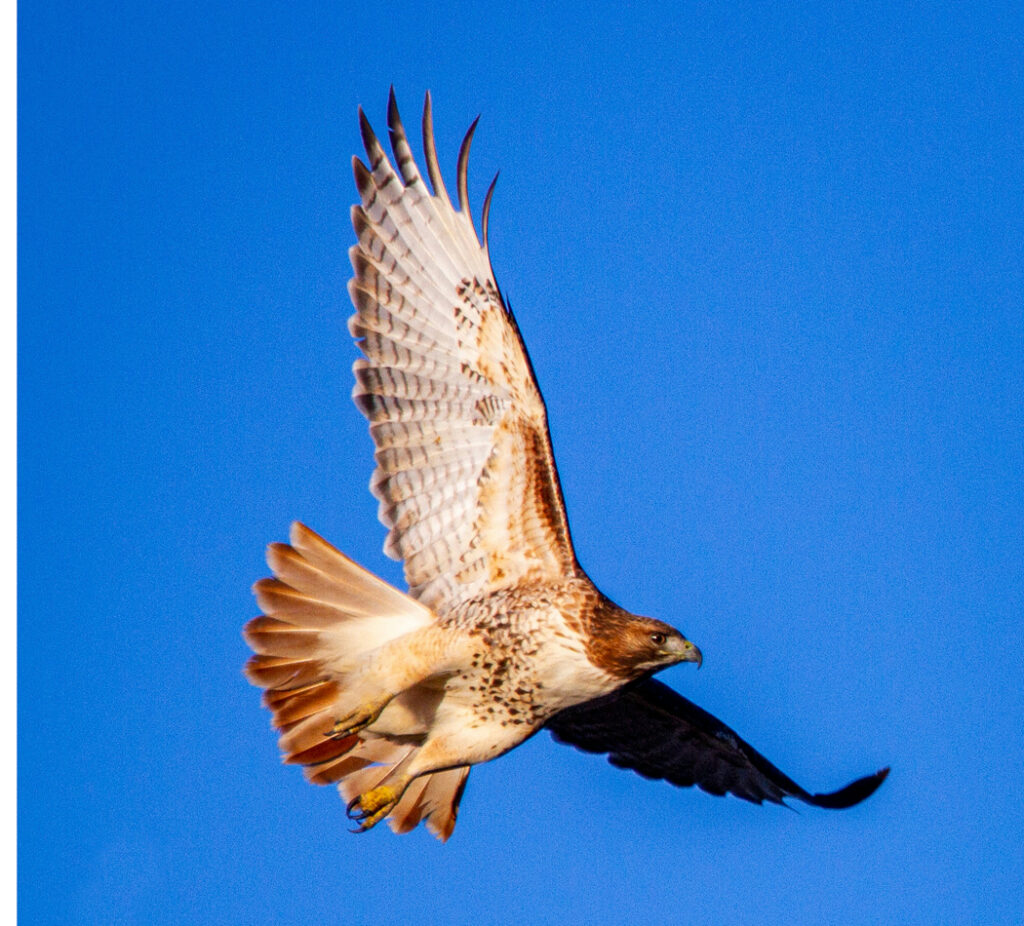
The Red-Tailed Hawk flies high above plains dominated by prairie grasses and farm fields, gliding almost effortlessly through the skies. These awe-inspiring birds of prey excel in aerial mastery and serve as unintentional educators in the continuously developing domain of biomimicry, a method of science and design that aims to replicate nature’s strategies to address complex problems.
Hawks are a prime source of inspiration for such inventive solutions. From their amazing aeronautical acrobatics to their excellent vision, hawks offer a goldmine of lessons waiting to be emulated by engineers.
Learning from hawks isn’t just about emulating their flight but also understanding the harmony with which they interact with their environment—a principle profoundly relevant through the biomimicry principle of “ethos.” Ethos in biomimicry encourages a shift from human-centered design to a more holistic, nature-informed perspective. The lessons learned from biomimicry remind us that the solutions we seek may have been present in nature all this time.
Soaring high above the ground, the Red-Tailed Hawk carefully looks for potential prey such as small mammals, birds, or reptiles. Its keen eyesight allows it to spot movement from a great distance.
Once the hawk spots its target, it positions itself upwind and above its prey, attempting to remain undetected for as long as possible. The hawk then folds its wings close to its body and enters a steep dive or “stoop” towards its prey, accelerating at astounding speeds. Despite the high speed of descent, the hawk keeps its focus locked on the target, adjusting its trajectory with precision to account for any sudden movements of the prey or changes in the environment. This technique is a testament to the hawk’s hunting prowess and its exceptional aerodynamic design, allowing for swift, controlled descents.

Then, just before impact, the hawk extends its legs forward, spreading its talons in preparation for the catch. The force of the stoop, combined with the sharp talons, is usually enough to subdue the prey upon impact. If needed, the hawk will use its beak to deliver a final, fatal bite to the neck or head of the prey to ensure it is captured efficiently. This hunting method makes the Red-Tailed Hawk one of the most formidable predators in the skies.
The biological mechanisms behind the hawk’s ability to maintain focus and navigate at such high speeds have inspired advancements in human technology, particularly in robotics and aeronautics. Engineers using biomimicry have mimicked the hawk’s “stooping” technique in developing drones. By mimicking the way hawks dive or “stoop” toward their prey, engineers designed drones to identify suitable landing zones from a distance. This involves executing a rapid and controlled descent while dynamically adjusting for real-time variables such as wind speed and unexpected obstacles.

Hawks possess extraordinary vision. Their eyesight is significantly better than that of humans because they have a higher number of photoreceptors (cones) in their retinas. This surplus of cones not only improves their long-distance vision but also enhances their color vision, enabling them to spot even the smallest movements or hidden prey.
Another fascinating aspect of hawks’ vision is their capability to see ultraviolet (UV) light. This UV vision allows them to track the urine trails of small prey animals, which reflect UV light, making it easier for hawks to hunt them down. Additionally, hawks have binocular vision, meaning both their eyes can focus on an object simultaneously, enabling the depth perception that is crucial for estimating the distance to their prey.
Hawks boast an expansive field of vision, aiding them in detecting prey or threats across vast distances. Additionally, they are equipped with a double fovea, a part of the eye vital for acute central vision. This distinctive characteristic enables them to keep a sharp focus on their target, whether it’s straight ahead or to the side, providing accuracy during rapid hunting descents.
These extraordinary traits—superior detail detection, UV visibility, deep focus, and an extensive field of view—are evolutionary adaptations that have made the hawk one of the most skilled hunters in the bird kingdom. The sharpness and versatility of their vision have also inspired advancements in human technology, especially in the development of advanced imaging systems designed to mimic the focus and refocus capabilities at different speeds and distances.
Studying the hawk’s prowess in hunting is just one way that biomimicry uses nature’s models to find solutions to complex engineering and design challenges.
